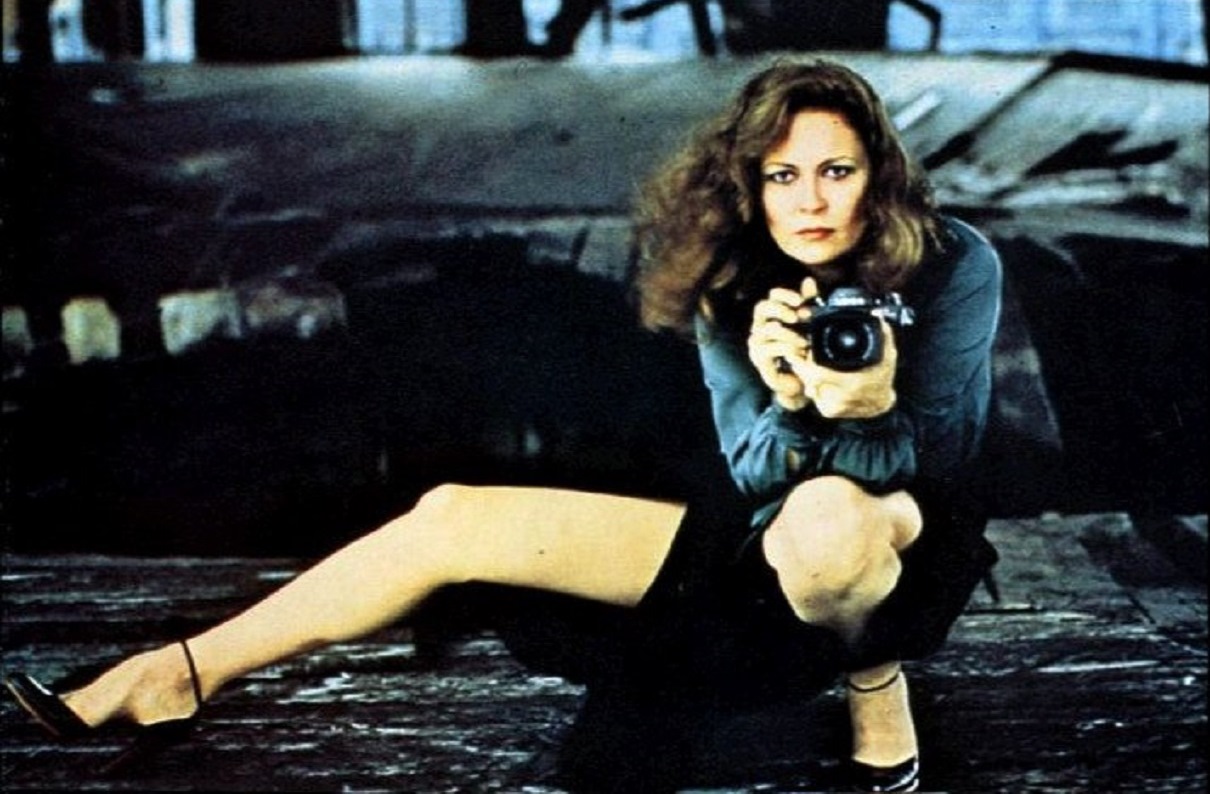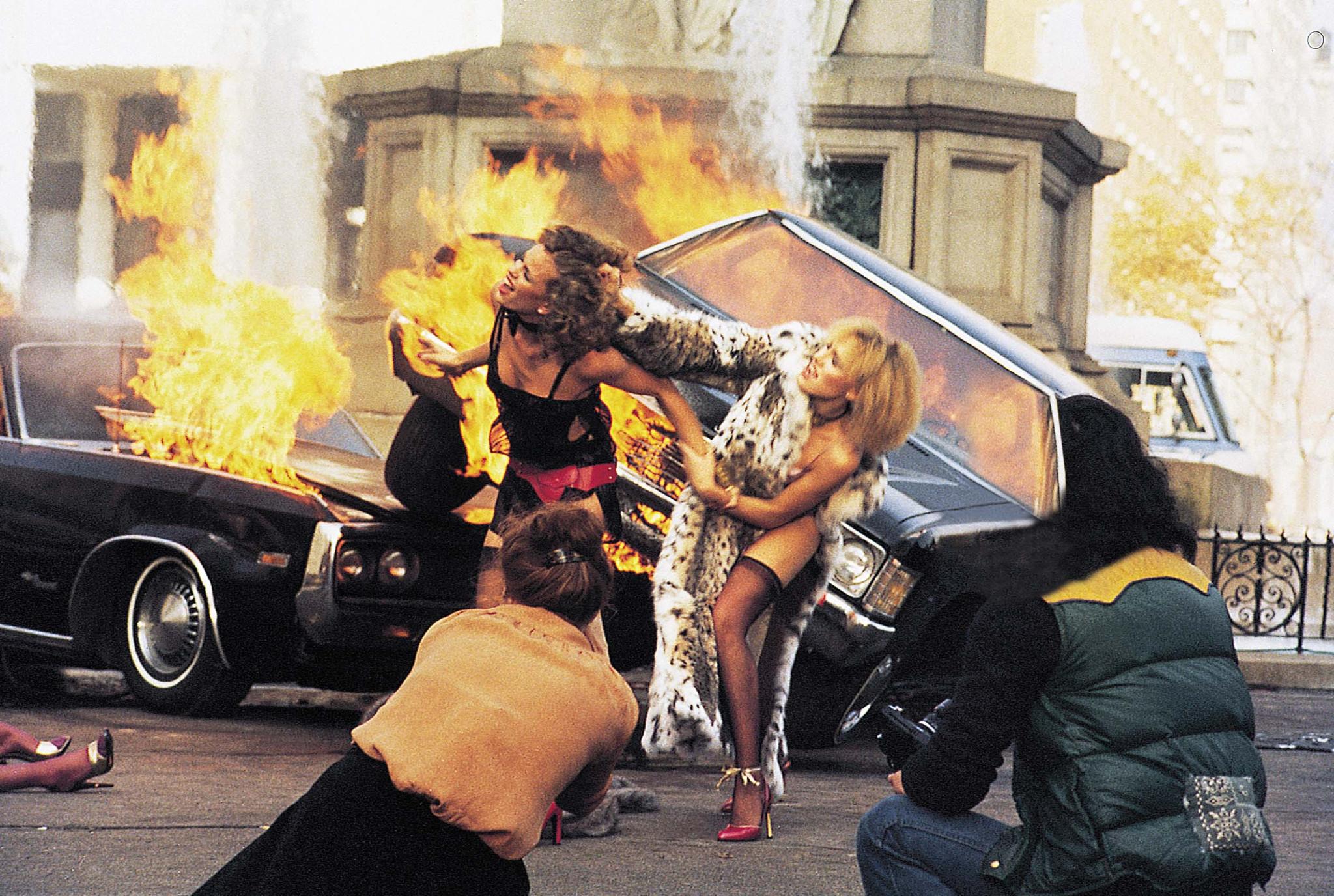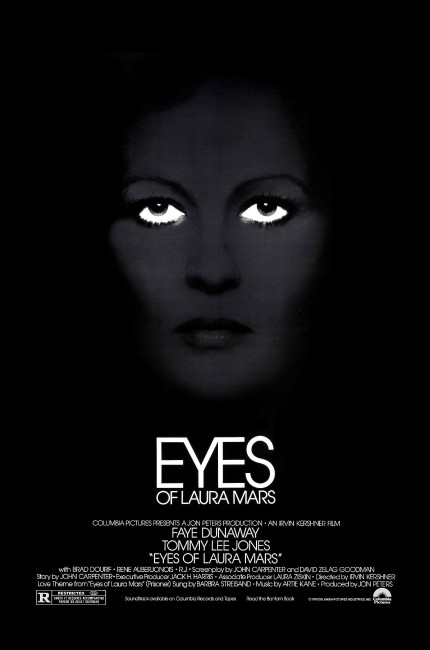USA. 1978.
Crew
Director – Irvin Kershner, Screenplay – John Carpenter & David Zelag Goodman, Story – John Carpenter, Additional Material – Julian Barry, Producer – Jon Peters, Photography – Victor J. Kemper, Fashion Stills – Rebecca Blake & Helmut Newton, Music – Artie Kane, Photographic Effects – James Liles, Special Effects – Edward Drohan, Production Design – Gene Callahan. Production Company – Jon Peters/Columbia.
Cast
Faye Dunaway (Laura Mars), Tommy Lee Jones (John Neville), Rene Auberjonois (Donald Phelps), Brad Dourif (Tommy Ludlow), Raul Julia (Michael Reisler), Frank Adonis (Sal Volpe), Lisa Taylor (Michele), Darlanne Fluegel (Lulu)
Plot
Fashion photographer Laura Mars is a controversial figure, having drawn considerable criticism for her provocative S&M-themed layouts. Just as Laura is about to open an exhibition, she has a vision of someone stabbing one of her friends with a pair of scissors. The next day she learns that her friend has been murdered in exactly the same way that she saw in her vision. The murders continue as her friends and colleagues are targeted, being killed in ways that mimic her fashion spreads and Laura always seeing the murder through the killer’s eyes. As the police become involved, Laura has difficulty explaining her visions to them.
This A-budget film was one of the most popular films to venture into the now cliched theme of the psychic who develops a link into the mind of a killer. Various permutations had previously been conducted in tv movies like Baffled! (1972), The Eyes of Charles Sand (1972), and Visions (1972). Eyes of Laura Mars was the first theatrical expansion of the idea and would go on to influence a surprising number of other clairvoyant murder mystery films, including the likes of Double Exposure (1981), Cassandra (1987), Fear (1990), Murderous Vision (1991), Dead On Sight (1994), Sensation (1994), Hideaway (1995), A Deadly Vision (1997), After Alice (1999), In Dreams (1999), The Gift (2000), Murder Scene (2000), Troubled Waters (2006), Empathy (2007), The Cell 2 (2009), Let Me Die Quietly (2009) and In/Sight (2011). (For a more detailed overview see Films About Clairvoyance and Precognition).
Eyes of Laura Mars was directed by Irvin Kershner who at that point had made comedies such as The Flim-Flam Man (1967) and S.P.Y.S. (1974), the proto-feminist Barbra Streisand vehicle Up the Sandbox (1972) and The Return of a Man Called Horse (1976). The most interesting name on the credits in retrospect was that of John Carpenter. At that point, Carpenter had made his famed student film Dark Star (1974) and the acclaimed low-budget siege film Assault on Precinct 13 (1976) and was bumming around Hollywood trying to sell scripts. Eyes of Laura Mars was the first of John Carpenter’s scripts to be produced.

John Carpenter’s script was purchased by Jon Peters, a former hairdresser who had then only produced the remake of A Star is Born (1976) and was most famous as Barbra Streisand’s boyfriend. (Peters would later go onto become a top Hollywood producer with Steven Spielberg and Tim Burton’s Batman films among many others). Peters originally saw the script as a vehicle for Streisand but she was turned off by the violence and the lead was then inherited by Faye Dunaway. Peters in the meantime had had Carpenter’s script rewritten by David Zelag Goodman, who also performed similar butchery duties on Logan’s Run (1976). Goodman’s major contribution was changing Carpenter’s ending regarding the identity of the killer, whom Carpenter had had as a derelict. Carpenter was not happy with the finished result. Later that same year, of course, Carpenter had great success with his runaway independent horror hit Halloween (1978), which, with fitting justness, was a success that completely overshadowed Eyes of Laura Mars at the box-office and made Carpenter’s name.
What makes Eyes of Laura Mars interesting is Irvin Kershner’s placing the otherwise routine story up against the chic stylism of a fashion background and provocative sadomasochistic imagery (where the film has employed real-life fashion photographer Helmut Newton, known for his S&M and fetish themed work, to stage the set-ups). This brings the film close to the Italian giallo films of the 1960s and 70s, in particular the work of Mario Bava and films like Blood and Black Lace (1964) and Hatchet for a Honeymoon/Blood Brides (1969) or the psycho-thrillers of Dario Argento, who both daringly blend the erotic and the sadistic at the same time. However, putting Eyes of Laura Mars up against this provocative backdrop only makes it seem even more tepid. It is a cheat, where the sado-erotic chic is merely provocative window dressing, no more than that. The killings could just as easily be set around a circus or a newspaper for all that such a setting matters to the film.
In the end, the psychic link, the mimicked murders and indeed the central premise, proves frustratingly irrelevant. The S&M poses are of no importance to the story – they drop off and are forgotten about a third of the way in – moreover it is never explained why the murders are mimicking the set-ups in the photos.

Worse, the revelation of the killer’s identity is gimmicky. It is never explained why Faye Dunaway and the particular individual happen to be psychically connected, nor why she is only able to see when they are conducting their killings and why not at any other particular period of time. (The same convenient deus ex machina improbability also infects all the abovementioned psychic thrillers – why does the psychic link only kick in when someone is killing, why not when they are doing mundane things like washing the dishes, watching tv or showering as well?) The end revelation of the killer’s identity is the film’s one effective moment. If the surprise is gimmicky and no real surprise, it is at least effectively wild in the tortured masochistic psychology it plumbs.
Irvin Kershner’s direction drags horribly. Each party and modelling shoot drags on as though it were the set piece instead of the killings. Kershner diverts off in long boring attempts to develop peripheral characters but when it comes to Rene Auberjonois’s shriekingly camp gay manager and Brad Dourif’s twitchy, eye-rolling ex-con chauffeur, the results are excruciating. Faye Dunaway gives a frail, neurotic performance, but is also surprisingly passive for someone who is meant to be the heroine of the show.
Director Irvin Kershner later became a director-for-hire on various genre sequels and turned out the well-above-average likes of The Empire Strikes Back (1980), the James Bond film Never Say Never Again (1983) and RoboCop 2 (1990). Kershner also produced the excellent psycho-thriller American Perfekt (1997).
Trailer here


